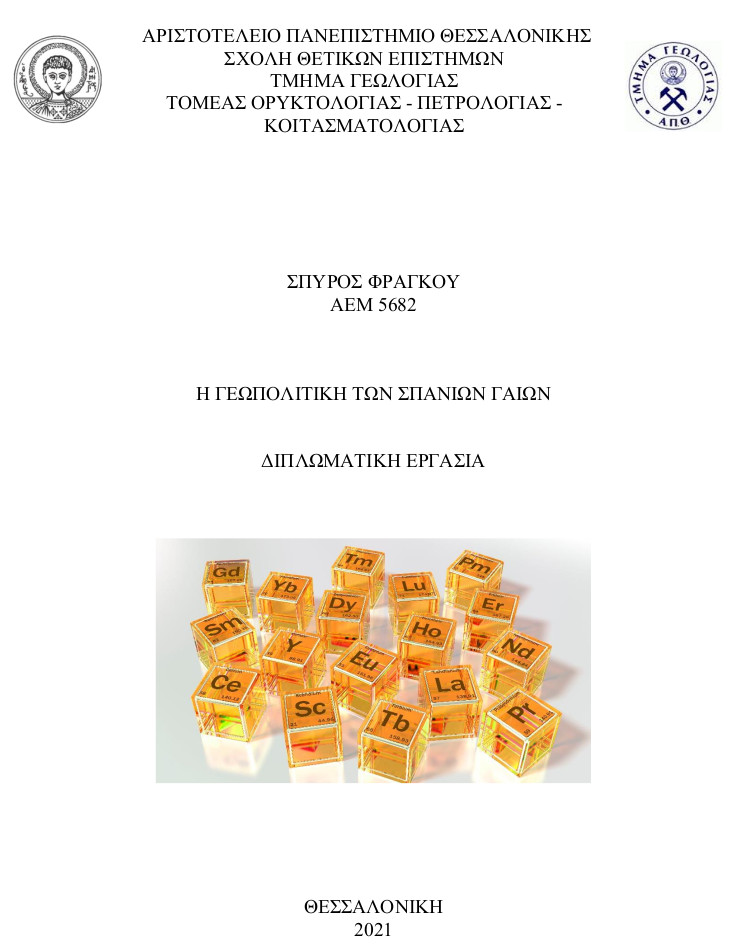
Η Γεωπολιτική των Σπανίων Γαιών = The Geopolitics of Rare-Earth Elements.
Περίληψη
The 21st century has been characterized as the most demanding in terms of mineral resources due to the great technological development that is taking place on our planet. The key to these modern technologies is a group of chemical elements, with unique properties, known as Rare-Earth Elements. The significance of these elements is confirmed by use of Rare-Earths as a means of exerting pressure on a geopolitical dispute between Japan and China in 2010. This fact alarmed a lot of countries and as a result most of these countries turned their attention to the research about Rare-Earth Elements. This diploma thesis focuses on the geopolitical importance of Rare-Earth Elements, the effects of Rare-Earth Crisis, the role of recycling in order to avoid similar crises in the future as well as the prospects of European and Greek rare earth deposits.
Πλήρες Κείμενο:
PDFΑναφορές
Anderson C.D., Taylor P.R. and Anderson C.G. 2017. Rare Earth Flotation Fundamentals: A Review. American Journal of Engineering Research, 6(11), 13p.
Balaram, V. (2019). Rare earth elements: A review of applications, occurrence, exploration, analysis, recycling, and environmental impact. Geoscience Frontiers, 10(4), 1285-1303.
Chapman, B. (2018). The geopolitics of rare earth elements: emerging challenge for US National Security and Economics. Journal of Self-Governance and Management Economics, 6(2), 50-91.
Cox, C., & Kynicky, J. (2018). The rapid evolution of speculative investment in the REE market before, during, and after the rare earth crisis of 2010–2012. The Extractive Industries and Society, 5(1), 8-17.
Dushyantha, N., Batapola, N., Ilankoon, I. M. S. K., Rohitha, S., Premasiri, R., Abeysinghe, B.,... & Dissanayake, K. (2020). The story of rare earth elements (REEs): occurrences, global distribution, genesis, geology, mineralogy and global production. Ore Geology Reviews, 103521.
Eliopoulos, D., Economou, G., Tzifas, I., & Papatrechas, C. (2014, September). The potential of rare earth elements in Greece. In Proceedings of the ERES2014: First European Rare Earth Resources Conference, Milos, Greece (pp. 4-7).
ENTR, D. (2014). Report on critical raw materials for the EU. European Commission.
EU Commission. (2011). Tackling the challenges in commodity markets and on raw materials. Brussels: European Commission.
European Commission. (2020). Critical raw materials resilience: Charting a path towards greater security and sustainability.
Gamaletsos, P. N., Godelitsas, A., Filippidis, A., & Pontikes, Y. (2019). The rare earth elements potential of Greek bauxite active mines in the light of a sustainable
REE demand. Journal of Sustainable Metallurgy, 5(1), 20-47.
Goodenough, K. M., Schilling, J., Jonsson, E., Kalvig, P., Charles, N., Tuduri, J.,... & Keulen, N. (2016). Europe's rare earth element resource potential: An overview of REE metallogenetic provinces and their geodynamic setting. Ore Geology Reviews, 72, 838-856.
Gov. Print. Off. Washington, DC. (2021) Rare Earths Statistics and Information. (https://www.usgs.gov/centers/nmic/rare-earths-statistics-and-information).
Habib, K., Hamelin, L., & Wenzel, H. (2016). A dynamic perspective of the geopolitical supply risk of metals. Journal of Cleaner Production, 133, 850-858.
Jowitt, S. M., Werner, T. T., Weng, Z., & Mudd, G. M. (2018). Recycling of the rare earth elements. Current Opinion in Green and Sustainable Chemistry, 13, 1-7.
Kanazawa, Y., & Kamitani, M. (2006). Rare earth minerals and resources in the world. Journal of alloys and compounds, 408, 1339-1343.
Klinger, J. M. (2018). Rare earth elements: Development, sustainability and policy issues. The Extractive Industries and Society, 5(1), 1-7.
Kumari, A., Panda, R., Jha, M. K., Kumar, J. R., & Lee, J. Y. (2015). Process development to recover rare earth metals from monazite mineral: A review. Minerals Engineering, 79, 102-115.
Liu, Y. L., Ling, M. X., Williams, I. S., Yang, X. Y., Wang, C. Y., & Sun, W. (2018). The formation of the giant Bayan Obo REE-Nb-Fe deposit, North China, Mesoproterozoic carbonatite and overprinted Paleozoic dolomitization. Ore Geology Reviews, 92, 73-83.
Massari, S., & Ruberti, M. (2013). Rare earth elements as critical raw materials: Focus on international markets and future strategies. Resources Policy, 38(1), 36-43.
United States Geological Survey (USGS), 2021. Mineral Commodity Summaries 2021.
Zepf, V. (2013). Rare earth elements: a new approach to the nexus of supply, demand and use: exemplified along the use of neodymium in permanent magnets. Springer Science & Business Media.
Μέλφος Β. (2020). Οι σπάνιες γαίες και η γεωπολιτική θέση της Ελλάδας. Ελληνικό Πανόραμα.
Εισερχόμενη Αναφορά
- Δεν υπάρχουν προς το παρόν εισερχόμενες αναφορές.
